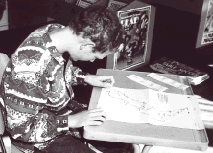| : Introduction | |
The assessments included eleven tasks which investigated students knowledge of the world in which they live and how it is represented. Knowledge is an important aid to understanding our world and developing confidence and skills to play an effective part as members of society. A fund of pertinent knowledge helps students to grow as informed citizens, enabling them to explore and think clearly and critically about issues that impact on their own and others' lives, and to build ideas and understandings that help them satisfy their interests and curiosity. Two of the eleven tasks were identical for year 4 and year 8, and two more were quite similar for both years but varied in the number of questions asked. Four further tasks were really two pairs, for which the year 4 and year 8 versions addressed the same concepts. However, they differed enough in details that there is no way of comparing the relative difficulty of the different versions, so they are presented separately here. Three tasks were attempted only by year 8 students. Five tasks have been selected as link tasks to be used again in the year 2001, and therefore are not described in detail here. The other tasks are released tasks for which full details are given. The chapter presents the assessment tasks in the following order:
|
|
| [ top of the page | Social Studies Report 1997 ] | |
 Overall, the
results show that year 8 students enjoyed greater success than year
4 students on all tasks that were common to both. However, within each
year the spread of performance ranged from very capable through to
poor. On a map of New Zealand, 30 percent of year 4 students accurately
to fairly accurately identified key locations compared to 65 percent
of year 8. Results for Charting the Journey show that many students
of both year 4 and year 8 have vague ideas about place on the world
map where New Zealand's first Mäori and European settlers came
from. About half of year 4 students and 85 percent of year 8 students
could place their home location on their own sketch map of New Zealand.
Many year 8 students struggled to identify correct answers in the tasks
that investigated their knowledge of some key information about New
Zealand and the world. Quite a high percentage of year 8 students showed
that they were capable of reading, understanding and interpreting a
basic topographical map.
Overall, the
results show that year 8 students enjoyed greater success than year
4 students on all tasks that were common to both. However, within each
year the spread of performance ranged from very capable through to
poor. On a map of New Zealand, 30 percent of year 4 students accurately
to fairly accurately identified key locations compared to 65 percent
of year 8. Results for Charting the Journey show that many students
of both year 4 and year 8 have vague ideas about place on the world
map where New Zealand's first Mäori and European settlers came
from. About half of year 4 students and 85 percent of year 8 students
could place their home location on their own sketch map of New Zealand.
Many year 8 students struggled to identify correct answers in the tasks
that investigated their knowledge of some key information about New
Zealand and the world. Quite a high percentage of year 8 students showed
that they were capable of reading, understanding and interpreting a
basic topographical map.